HYUNDAI KONA EV 2023 Owner's Manual
Manufacturer: HYUNDAI, Model Year: 2023, Model line: KONA EV, Model: HYUNDAI KONA EV 2023Pages: 548, PDF Size: 49.14 MB
Page 21 of 548
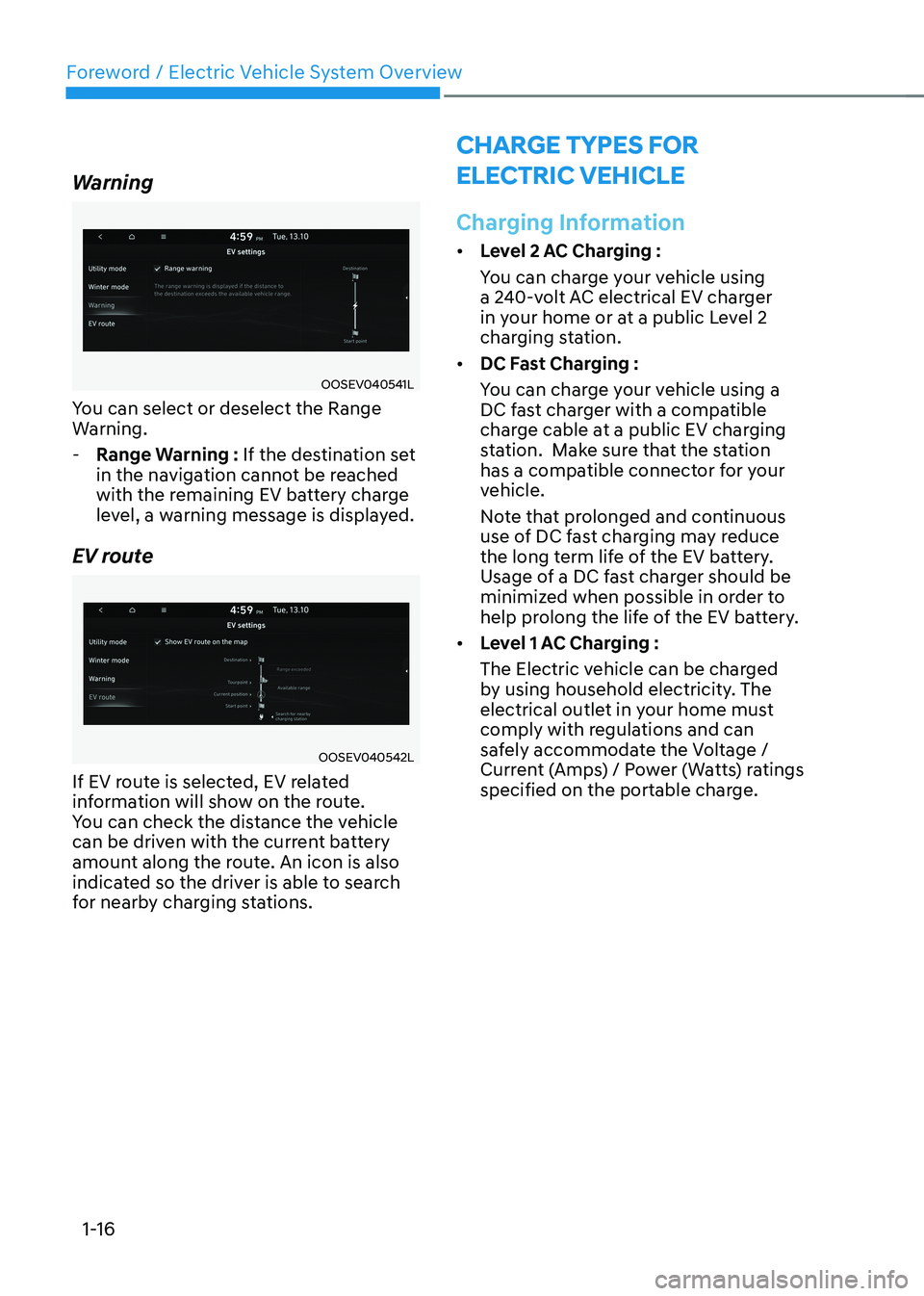
Foreword / Electric Vehicle System Overview
1-16
Warning
OOSEV040541L
You can select or deselect the Range
Warning.
- Range Warning : If the destination set
in the navigation cannot be reached
with the remaining EV battery charge
level, a warning message is displayed.
EV route
OOSEV040542L
If EV route is selected, EV related
information will show on the route.
You can check the distance the vehicle
can be driven with the current battery
amount along the route. An icon is also
indicated so the driver is able to search
for nearby charging stations.
CHarge Types For
eleCTriC VeHiCle
Charging Information
• Level 2 AC Charging :
You can charge your vehicle using
a 240-volt AC electrical EV charger
in your home or at a public Level 2
charging station.
• DC Fast Charging :
You can charge your vehicle using a
DC fast charger with a compatible
charge cable at a public EV charging
station. Make sure that the station
has a compatible connector for your
vehicle.
Note that prolonged and continuous
use of DC fast charging may reduce
the long term life of the EV battery.
Usage of a DC fast charger should be
minimized when possible in order to
help prolong the life of the EV battery.
• Level 1 AC Charging :
The Electric vehicle can be charged
by using household electricity. The
electrical outlet in your home must
comply with regulations and can
safely accommodate the Voltage /
Current (Amps) / Power (Watts) ratings
specified on the portable charge.
Page 22 of 548
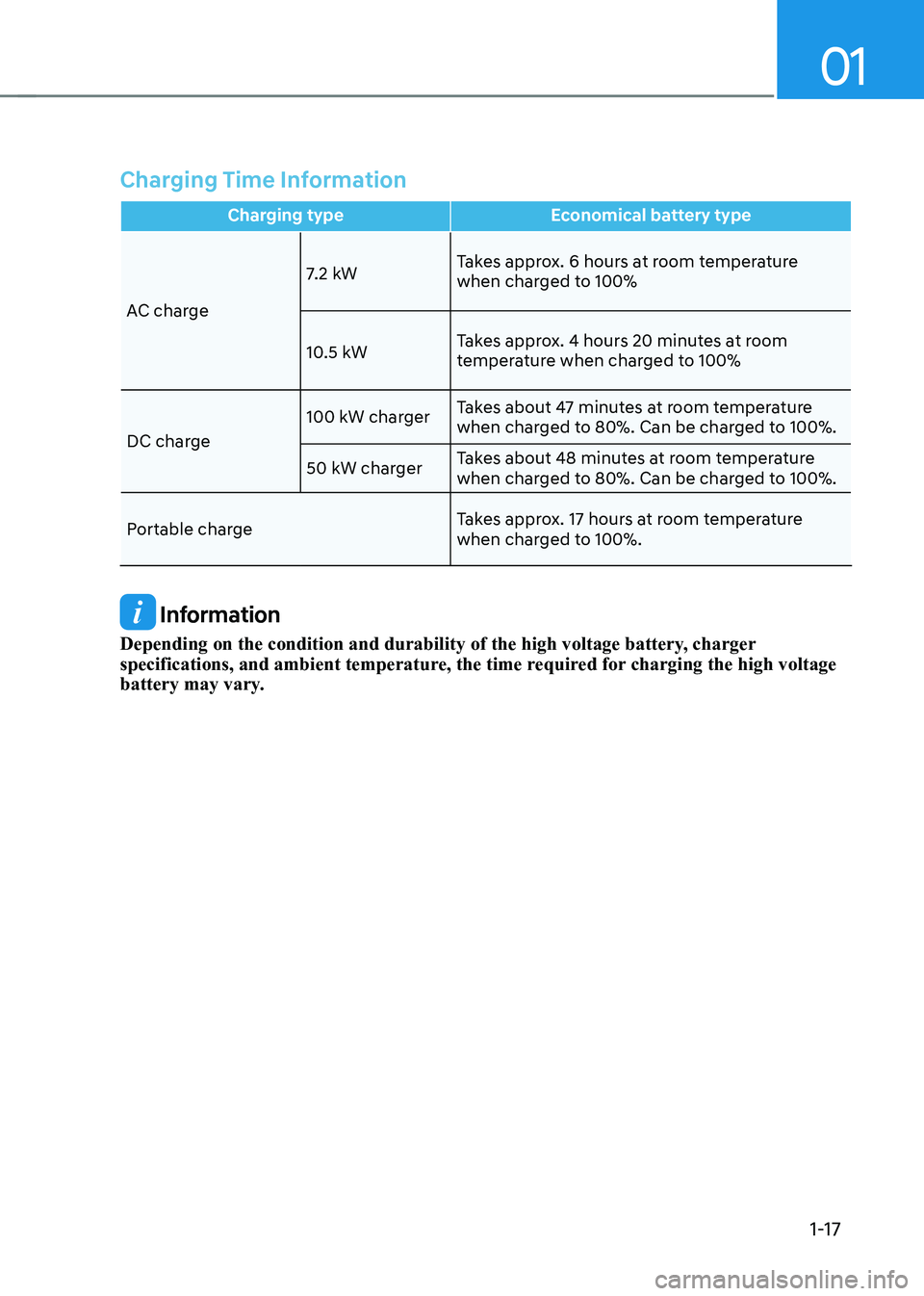
01
1-17
Charging Time Information
Charging type Economical battery type
AC charge7.2 kW
Takes approx. 6 hours at room temperature
when charged to 100%
10.5 kW Takes approx. 4 hours 20 minutes at room
temperature when charged to 100%
DC charge 100 kW charger
Takes about 47 minutes at room temperature
when charged to 80%. Can be charged to 100%.
50 kW charger Takes about 48 minutes at room temperature
when charged to 80%. Can be charged to 100%.
Portable charge Takes approx. 17 hours at room temperature
when charged to 100%.
Information
Depending on the condition and durability of the high voltage battery, charger
specifications, and ambient temperature, the time required for charging the high voltage
battery may vary.
Page 23 of 548
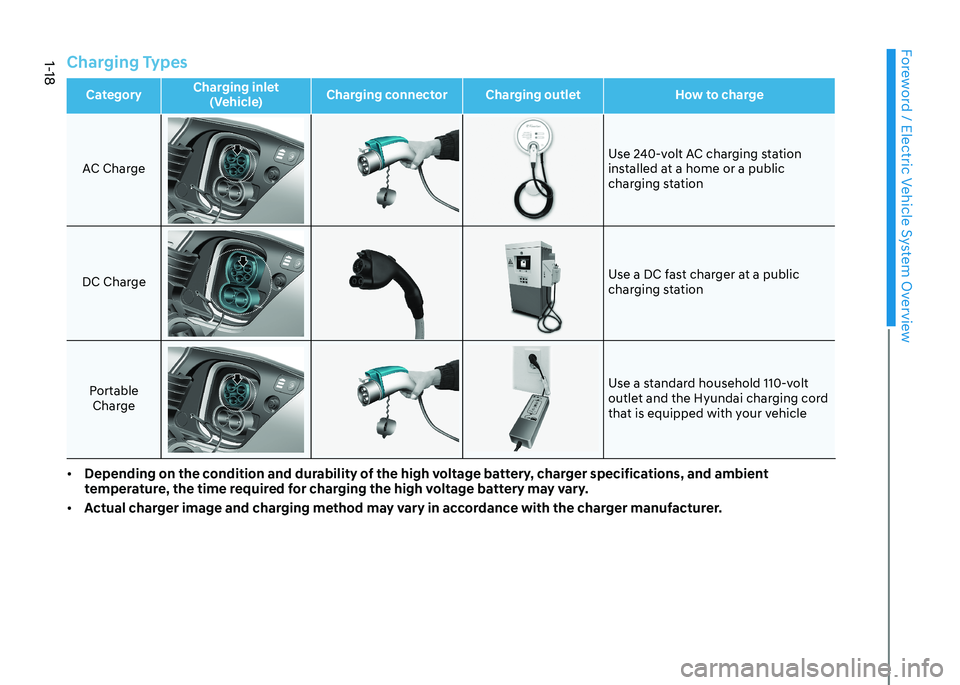
Foreword / Electric Vehicle System Overview
1-18
Charging Types
CategoryCharging inlet
(Vehicle) Charging connector Charging outlet How to chargeAC Charge
Use 240-volt AC charging station
installed at a home or a public
charging station
DC ChargeUse a DC fast charger at a public
charging station
Portable Charge Use a standard household 110-volt
outlet and the Hyundai charging cord
that is equipped with your vehicle
• Depending on the condition and durability of the high voltage battery, charger specifications, and ambient
temperature, the time required for charging the high voltage battery may vary.
• Actual charger image and charging method may vary in accordance with the charger manufacturer.
Page 24 of 548
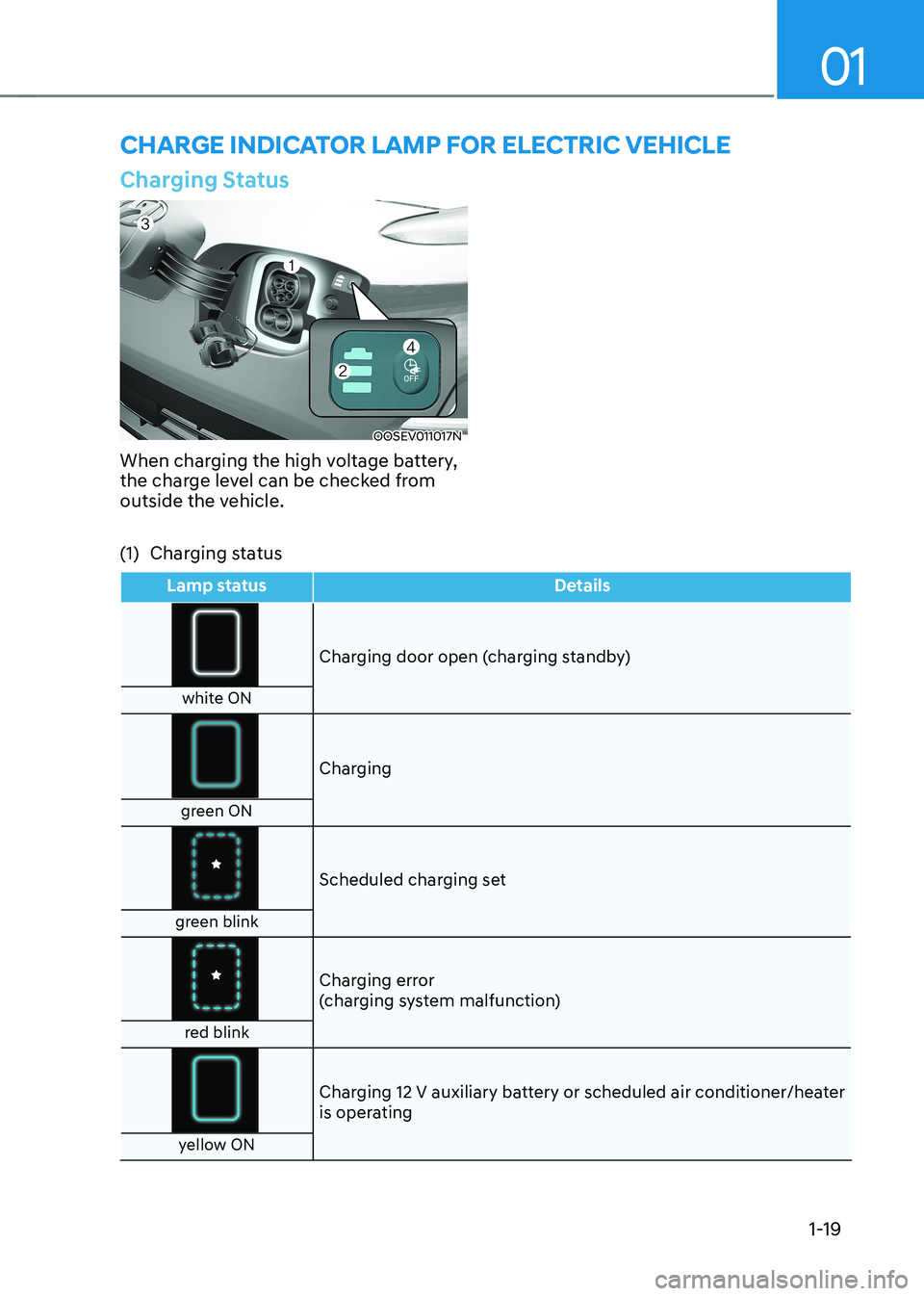
01
1-19
CHarge indiCaTor lamp For eleCTriC VeHiCle
Charging Status
OOSEV011017N
When charging the high voltage battery,
the charge level can be checked from
outside the vehicle.
(1) Charging status
Lamp status Details
Charging door open (charging standby)
white ON
Charging
green ON
Scheduled charging set
green blink
Charging error
(charging system malfunction)
red blink
Charging 12 V auxiliary battery or scheduled air conditioner/heater
is operating
yellow ON
Page 25 of 548
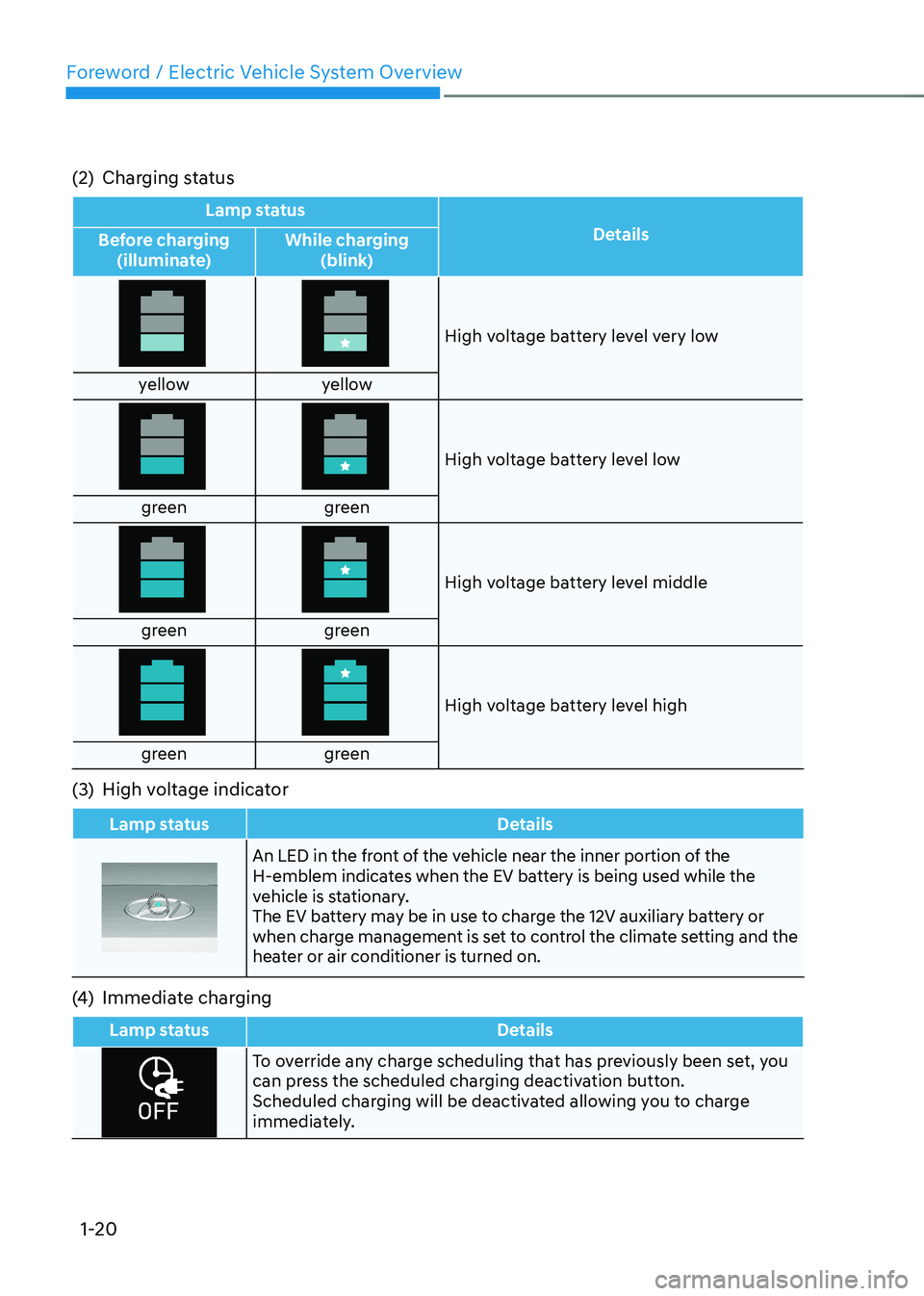
Foreword / Electric Vehicle System Overview
1-20
(2) Charging status
Lamp status
Details
Before charging
(illuminate) While charging
(blink)
High voltage battery level very low
yellow yellow
High voltage battery level low
green green
High voltage battery level middle
green green
High voltage battery level high
green green
(3) High voltage indicator
Lamp status Details
An LED in the front of the vehicle near the inner portion of the
H-emblem indicates when the EV battery is being used while the
vehicle is stationary.
The EV battery may be in use to charge the 12V auxiliary battery or
when charge management is set to control the climate setting and the
heater or air conditioner is turned on.
(4) Immediate charging
Lamp status Details
To override any charge scheduling that has previously been set, you
can press the scheduled charging deactivation button.
Scheduled charging will be deactivated allowing you to charge
immediately.
Page 26 of 548
![HYUNDAI KONA EV 2023 Owners Manual 01
1-21
CHarging ConneCTor loCK
Charging Connector AUTO/
LOCK Mode
OOSEVQ019006
[A] : Auto mode, [B] : Lock mode
You can change the setting that locks
the charging connector to the charging
port HYUNDAI KONA EV 2023 Owners Manual 01
1-21
CHarging ConneCTor loCK
Charging Connector AUTO/
LOCK Mode
OOSEVQ019006
[A] : Auto mode, [B] : Lock mode
You can change the setting that locks
the charging connector to the charging
port](/img/35/56170/w960_56170-25.png)
01
1-21
CHarging ConneCTor loCK
Charging Connector AUTO/
LOCK Mode
OOSEVQ019006
[A] : Auto mode, [B] : Lock mode
You can change the setting that locks
the charging connector to the charging
port on the vehicle. Change the mode
using the Charging AUTO / LOCK button
located on the left of the driver side dash
panel.Press the (
) button to change
between AUTO mode and LOCK mode.
Information
The charging inlet is locked during the DC
charge regardless of AUTO/ LOCK mode.
After charging is complete the locked charging inlet is unlocked. When the Charging Connector Is
Locked
LOCK
AUTO
Before charging O X
While charging O O
Finished charging O X
• LOCK mode (button indicator off) :
The connector locks when the
charging connector is plugged into
the charging port. The connector is
locked until all doors are unlocked by
the driver. This mode can be used to
prevent charging cable theft.
- If the charge connector is not disconnected within 15 seconds
after unlocking all doors, the
connector will be automatically
locked again.
- The charge connector will automatically relock when all the
doors of the vehicle are locked.
• AUTO mode (button indicator on) :
The connector locks when charging
starts. The connector unlocks when
charging is complete. This mode can
be used when charging in a public
charging station.
Page 27 of 548
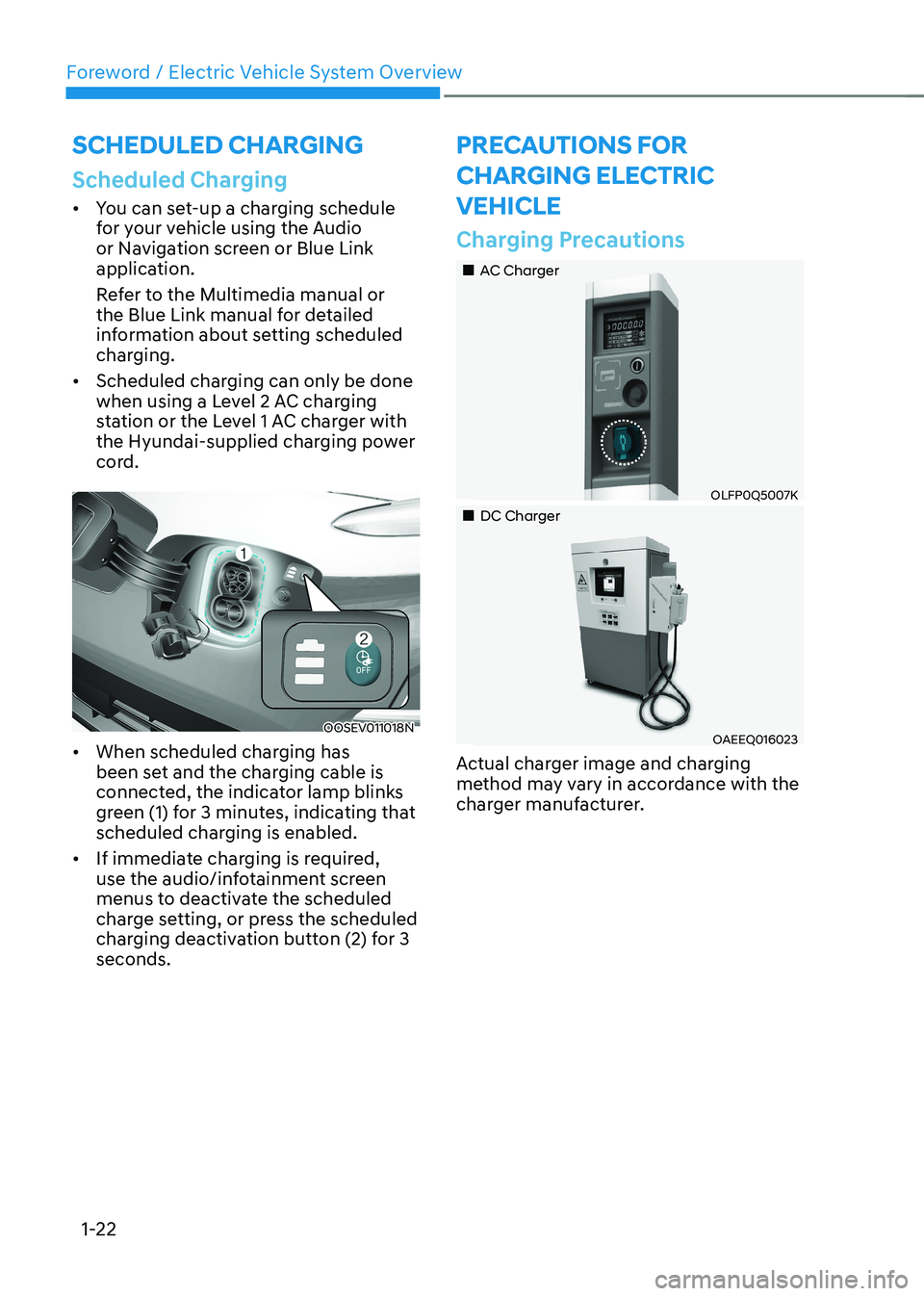
Foreword / Electric Vehicle System Overview
1-22
sCHeduled CHarging
Scheduled Charging
• You can set-up a charging schedule
for your vehicle using the Audio
or Navigation screen or Blue Link
application.
Refer to the Multimedia manual or
the Blue Link manual for detailed
information about setting scheduled
charging.
• Scheduled charging can only be done
when using a Level 2 AC charging
station or the Level 1 AC charger with
the Hyundai-supplied charging power
cord.
OOSEV011018N
• When scheduled charging has
been set and the charging cable is
connected, the indicator lamp blinks
green (1) for 3 minutes, indicating that
scheduled charging is enabled.
• If immediate charging is required,
use the audio/infotainment screen
menus to deactivate the scheduled
charge setting, or press the scheduled
charging deactivation button (2) for 3 seconds.
preCauTions For
CHarging eleCTriC VeHiCle
Charging Precautions
„„AC Charger
OLFP0Q5007K
„„DC Charger
OAEEQ016023
Actual charger image and charging
method may vary in accordance with the
charger manufacturer.
Page 28 of 548
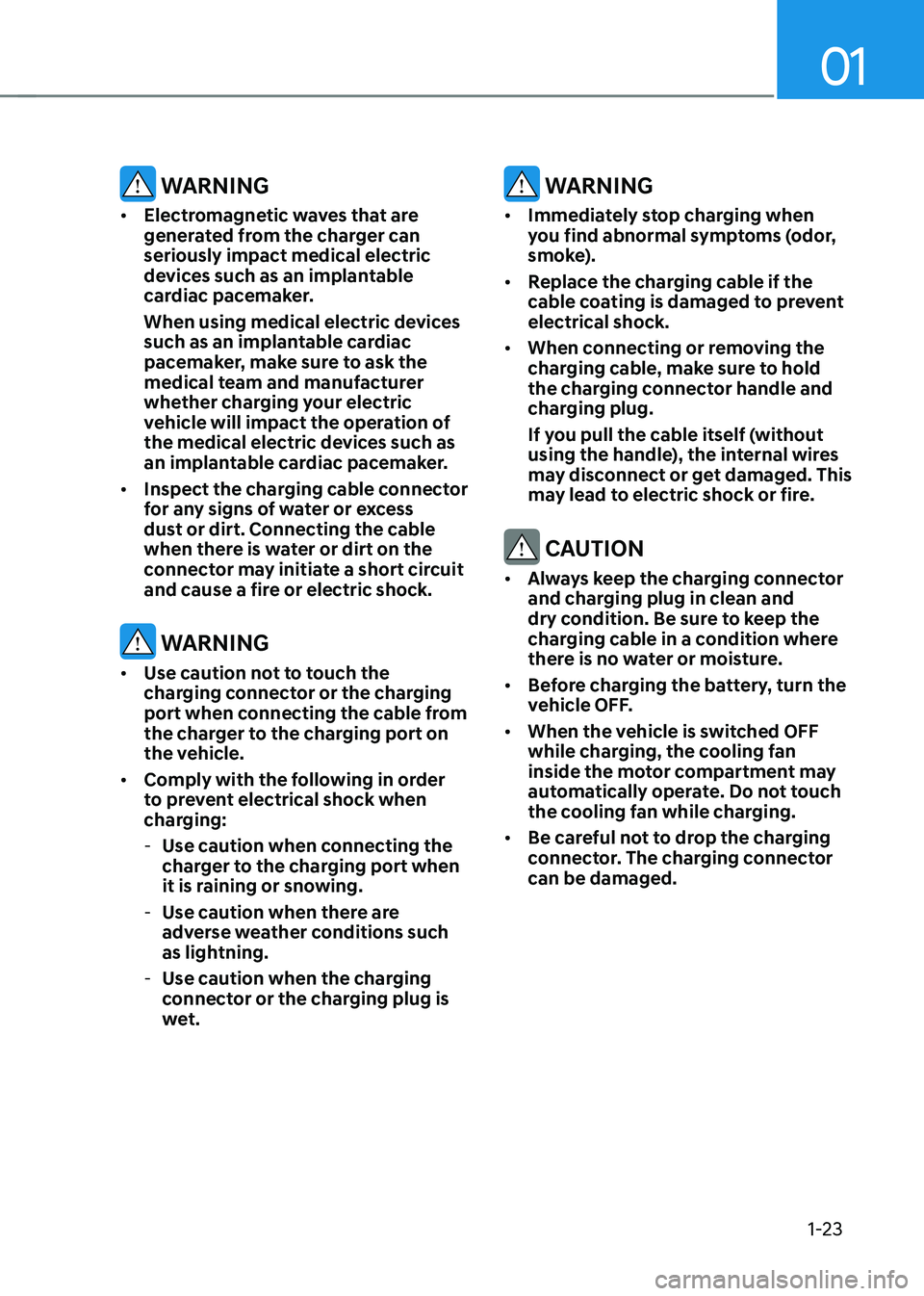
01
1-23
WARNING
• Electromagnetic waves that are
generated from the charger can seriously impact medical electric
devices such as an implantable
cardiac pacemaker.
When using medical electric devices
such as an implantable cardiac
pacemaker, make sure to ask the
medical team and manufacturer
whether charging your electric
vehicle will impact the operation of
the medical electric devices such as
an implantable cardiac pacemaker.
• Inspect the charging cable connector
for any signs of water or excess
dust or dirt. Connecting the cable
when there is water or dirt on the
connector may initiate a short circuit
and cause a fire or electric shock.
WARNING
• Use caution not to touch the
charging connector or the charging
port when connecting the cable from
the charger to the charging port on
the vehicle.
• Comply with the following in order
to prevent electrical shock when
charging:
- Use caution when connecting the
charger to the charging port when
it is raining or snowing.
- Use caution when there are
adverse weather conditions such
as lightning.
- Use caution when the charging
connector or the charging plug is
wet.
WARNING
• Immediately stop charging when
you find abnormal symptoms (odor,
smoke).
• Replace the charging cable if the
cable coating is damaged to prevent electrical shock.
• When connecting or removing the
charging cable, make sure to hold
the charging connector handle and
charging plug.
If you pull the cable itself (without
using the handle), the internal wires
may disconnect or get damaged. This
may lead to electric shock or fire.
CAUTION
• Always keep the charging connector
and charging plug in clean and
dry condition. Be sure to keep the
charging cable in a condition where
there is no water or moisture.
• Before charging the battery, turn the
vehicle OFF.
• When the vehicle is switched OFF
while charging, the cooling fan
inside the motor compartment may
automatically operate. Do not touch
the cooling fan while charging.
• Be careful not to drop the charging
connector. The charging connector can be damaged.
Page 29 of 548
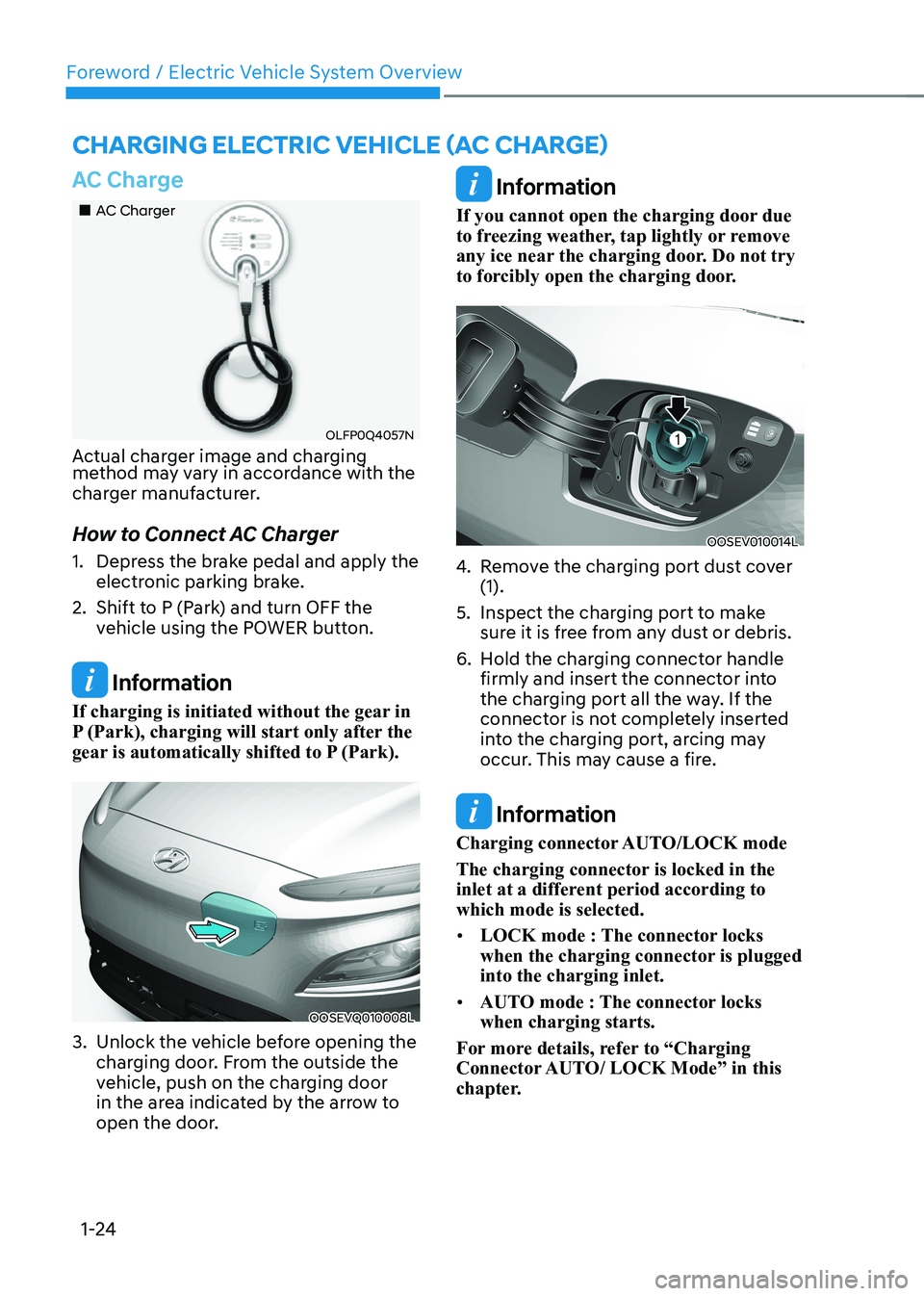
Foreword / Electric Vehicle System Overview
1-24
AC Charge
„„AC Charger
OLFP0Q4057N
Actual charger image and charging
method may vary in accordance with the
charger manufacturer.
How to Connect AC Charger
1. Depress the brake pedal and apply the electronic parking brake.
2. Shift to P (Park) and turn OFF the vehicle using the POWER button.
Information
If charging is initiated without the gear in
P (Park), charging will start only after the
gear is automatically shifted to P (Park).
OOSEVQ010008L
3. Unlock the vehicle before opening the charging door. From the outside the
vehicle, push on the charging door
in the area indicated by the arrow to
open the door.
Information
If you cannot open the charging door due
to freezing weather, tap lightly or remove
any ice near the charging door. Do not try
to forcibly open the charging door.
OOSEV010014L
4. Remove the charging port dust cover (1).
5. Inspect the charging port to make sure it is free from any dust or debris.
6. Hold the charging connector handle firmly and insert the connector into
the charging port all the way. If the
connector is not completely inserted
into the charging port, arcing may
occur. This may cause a fire.
Information
Charging connector AUTO/LOCK mode
The charging connector is locked in the
inlet at a different period according to which mode is selected. • LOCK mode : The connector locks
when the charging connector is plugged into the charging inlet.
• AUTO mode : The connector locks when charging starts.
For more details, refer to “Charging
Connector AUTO/ LOCK Mode” in this
chapter.
Charging ElECtriC VEhiClE (aC ChargE)
Page 30 of 548
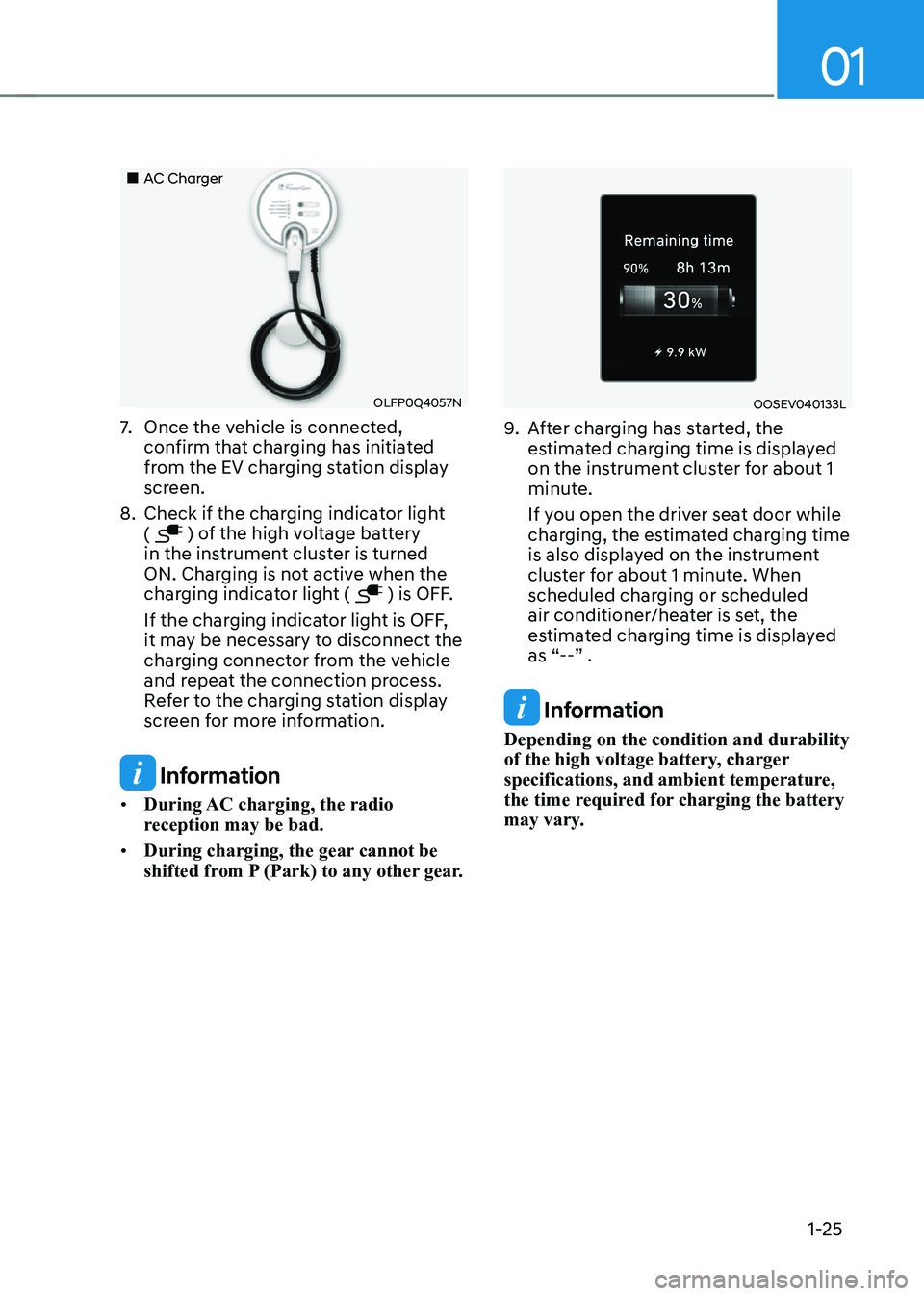
01
1-25
„„AC Charger
OLFP0Q4057N
7. Once the vehicle is connected,
confirm that charging has initiated
from the EV charging station display
screen.
8. Check if the charging indicator light (
) of the high voltage battery
in the instrument cluster is turned
ON. Charging is not active when the
charging indicator light (
) is OFF.
If the charging indicator light is OFF,
it may be necessary to disconnect the
charging connector from the vehicle
and repeat the connection process.
Refer to the charging station display
screen for more information.
Information
• During AC charging, the radio
reception may be bad.
• During charging, the gear cannot be
shifted from P (Park) to any other gear.
OOSEV040133L
9. After charging has started, the
estimated charging time is displayed
on the instrument cluster for about 1
minute.
If you open the driver seat door while
charging, the estimated charging time
is also displayed on the instrument
cluster for about 1 minute. When
scheduled charging or scheduled
air conditioner/heater is set, the
estimated charging time is displayed
as “--” .
Information
Depending on the condition and durability
of the high voltage battery, charger
specifications, and ambient temperature,
the time required for charging the battery
may vary.